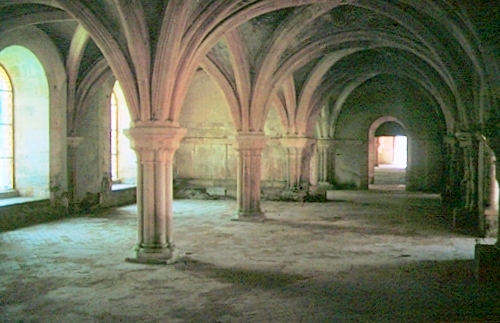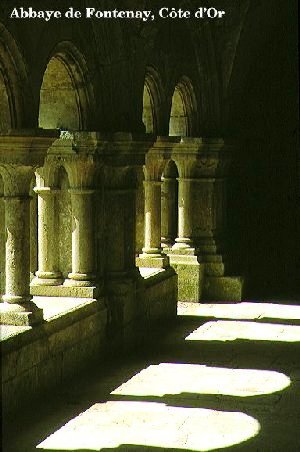|
Fontenay
|
||
| By the end of the eleventh century the life of a monk in the Duchy
of Burgundy was very different from what St. Benedict had originally
intended. The thousand monasteries of the Cluniac order were rich and
powerful; the mother house at Cluny included in its buildings
the biggest church in Christendom. The Abbot of Cluny, who ranked as
a Bishop and answered to the Pope alone, never travelled without a
suite of at least sixty horsemen. The monks ate off silver, their
light came from golden candlesticks. Wherever the wind blew, said the
people, the monks collected rent. ln the year lll2 a young man of 21 entered the Abbey of Citeaux. So plainly out of the ordinary was he, that within three years he was Abbot. We know him now as Saint Bernard, and he founded the Cistercian order in reaction against the extravagances of Cluny. In the North of Burgundy he founded new Abbeys, on barren sites, their buildings of the most extreme simplicity. Stone and wood and iron were his materials, and the monks did their own building and farming, dividing their work time between manual and intellectual work They slept in a communal dormitory, on straw mattresses on the floor, without heating in winter, in the same rough habits they wore in the daytime. They ate boiled vegetables and drank spring water. Each day brought seven hours of worship, seven hours of rest and eight hours of work. The other two hours were for meals and meetings. They vowed, like all monks, poverty, chastity and obedience; but the House itself was also vowed to poverty. A Cistercian Abbey was in theory self-supporting; it collected no tithes, owned no land outside its walls, accepted no rich gifts. Even the height of its towers was restricted. The Abbey of Fontenay was begun in 1118, massive, simple, beautiful. At first it was a few simple buildings in a green valley surrounded by springs. The monks dug iron ore from a nearby hill and smelted and worked the iron in a vast forge. The forge is as big as the church, built in the same solid, simple style. The streams of the area were canalized for water-power, and the waste water fed a series of trout ponds and fountains which gave the Abbey its name. After St. Bernard's death, human nature being what it is, his Cistercians went the way of the Cluniacs before them; they became richer, fatter, lazier. The Abbeys decayed, and when they were dissolved at the Revolution, few mourned their passing. The land and buildings were sold to finance the revolutionary wars. In 1789, the Abbey of Fontenay was sold to a factory-owner, who turned it into a paper-mill. He sold it on to the Montgolfier family, inventors of the hot-air balloon. The balloons, in fact, were constructed out of paper made at Fontenay. A branch of the same family still owns the place, but in 1906 they closed the factory, pulled down the 19th-century workshops, and began the work of restoration that continues to this day. In 1981, when UNESCO was drawing up a list of World Heritage Sites, Fontenay was among the first to be listed. It is a very special place. founded by a very special man and still permeated with his spirit.
|

|
|



